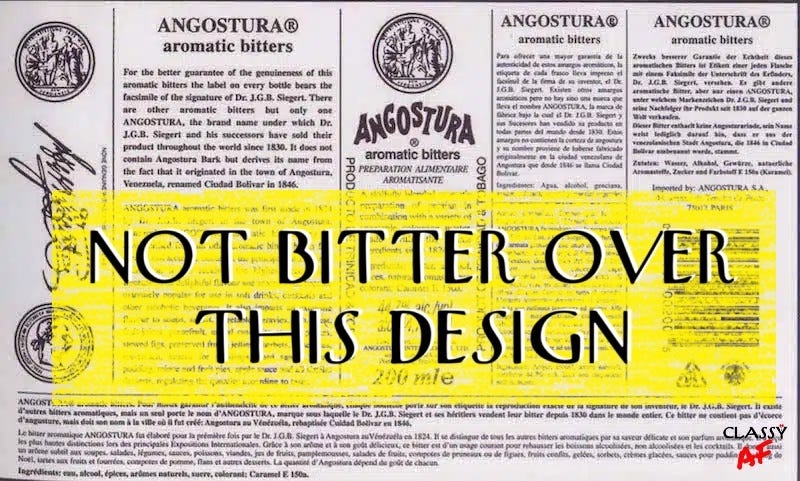Have you ever seen a bottle of Angostura bitters and wondered why the label looks too big?
Believe it or not, it was a mistake. Until it wasn’t.
The story of Angostura bitters goes back to the 1820s, when it was developed as a tonic for stomach ailments by Dr. Johann Gottlieb Benjamin Siegert, who lived in the town of Angostura, Venezuela. He served as Surgeon General in Simón Bolívar’s army and perfected his formula for Amargo Aromatico as a medical elixir for the soldiers.
In 1850, Dr. Siegert began exporting his bitters to England, the Caribbean, and the United States, and his timing couldn’t have been more perfect: it was the cusp of the golden age of cocktails.
Following the death of Dr. Siegert in 1870, his sons Carlos, Alfredo, and Luis Siegert assumed control of the business and subsequently moved its operations to Trinidad & Tobago.
To promote the business in its new location, the trio decided to enter the bitters into a competition, redesigning the bottle and the label. Because they were in a rush to be ready for the competition, one brother designed the bottle, the other designed the label.
And in a classic move of miscommunication, they didn’t coordinate.
By the time they were done, it was too late for either to adapt their contribution to the poorly planned group project. So they put the huge label on the little bottle and submitted their work.
While Angostura aromatic bitters didn’t win that competition, it went on to win the Medal of Excellence in Vienna, Austria in 1873, and a gold medal for Product Excellence at the World Trade Fair in Philadelphia, USA in 1876.
And the design remains — a quirky, mistake of a design that has differentiated Angostura aromatic bitters from the rest of the market.
Try It — You Won’t Be Bitter
If you’d like to see what the fuss is about, you can try this 44.7% alc./vol. cocktail enhancer yourself. It is a combination of some 40 botanicals that are known to only five people at a time. They include gentian root, cardamom, citrus fruits, and vegetable extracts.
The label itself has helpful recipes you can try:
Manhattan Cocktail
1 or 2 dashes of Angostura
2 parts whiskey
1 part sweet vermouth
Pour over ice in a mixing glass. Stir, strain and serve.
Trinidad & Tobago Rum Punch
1 1/2 oz. Trinidad rum
1 1/2 oz. lemon or lime juice
1/2 oz. Grenadine
1 or 2 dashes Angostura.
Pour over cracked ice into large Collins glass. Fill with club soda. Stir. Garnish with pineapple spear, cherry, and lemon or orange slice. Serve with straws.
Classic Daquiri
2 oz. Angostura 1919 rum
1 oz. fresh sweet and sour
2 oz. simple syrup
3 dashes Angostura bitters
Pour all ingredients into an ice-filled shaker. Shake well. Serve in a Martini glass. Garnish with lemon wheel and cherry.
Southampton (non-alcoholic)
Fill a tall glass with ice. Add tonic water, squeeze of lime, 3 dashes of Angostura. Stir and serve with a straw. Garnish with a lime wheel.
It’s Not Just for Cocktails
In addition to cocktails, Angostura bitters can be used in a variety of recipes. For example:
Fruits: for cooked or canned fruits, add 2-3 dashes Angostura or flavor to taste.
Salads: Blend 2 or 3 dashes Angostura with each cup of mayonnaise, French, or other salad dressing.
Pies: Add 4 or 5 dashes Angostura per cup of mince meat or pumpkin filling, 1 or 2 dashes to apple or other fruit.
Soups: Add 1 or 2 dashes Angostura to each served of canned or frozen soup, fish chowder, bisques, and chicken soups. Stir in at last minute.
Do you have a favorite recipe you use Angostura bitters in? Share it.
Look at you, all Classy AF with your Angostura-inspired cocktails!










Not kidding, the Manhattan has been my family's drink for decades. When I took my fiancé to his first family gathering, I warned him to be ready. My uncles tended to be heavy with the pours. He was initiated! We make them on our own. Korbel is our go-to brandy (which is used instead of Whiskey).
I have had a life-long love of Angostura Bitters and I never knew any of this! I realize also I'm going to have to finally break down and see what a Manhattan tastes like....